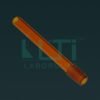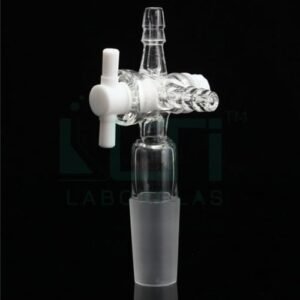Acc. to DIN 12249
| Part No. | CONE Size | Approx. O.D. Of Tube | Total length (mm) | Pack (qty.) |
| 1290-10C | 10/19 | 8 | 120±10 | 10 |
| 1290-12C | 12/21 | 9 | 120±10 | 10 |
| 1290-14C | 14/23 | 13 | 120±10 | 10 |
| 1290-19C | 19/26 | 16 | 125±10 | 10 |
| 1290-24C | 24/29 | 22 | 135±10 | 10 |
| 1290-29C | 29/32 | 26 | 135±10 | 10 |
| 1290-34C | 34/35 | 30 | 150±10 | 10 |
| 1290-40C | 40/38 | 36 | 150±10 | 10 |
| 1290-45C | 45/40 | 40 | 150±10 | 10 |
| 1290-50C | 50/42 | 45 | 150±10 | 10 |
Here are a few common uses for amber-colored glass cones in laboratory settings:
- Light-Sensitive Samples: Amber glass provides protection against light, especially ultraviolet light. In situations where a sample is light-sensitive and can be degraded or altered by exposure to light, amber glass cones may be used to shield the contents from UV and visible light.
- Chemical Reagents: Certain chemicals may be sensitive to light and can undergo degradation or decomposition when exposed to UV or visible light. Using amber glass cones for storing or handling these reagents helps maintain their stability and integrity.
- Photometric Measurements: In analytical chemistry, particularly in photometry and spectrophotometry, amber glass may be used in sample containers to prevent interference from ambient light during measurements.
- Photosensitive Reactions: In chemical reactions or processes where light can catalyze or affect the outcome, amber glass cones may be employed to shield the reaction mixture from external light sources.
- Storage of Light-Sensitive Solutions: When storing solutions that are prone to degradation in the presence of light, such as certain pharmaceuticals or biological samples, amber glass cones can be used to protect the contents.







